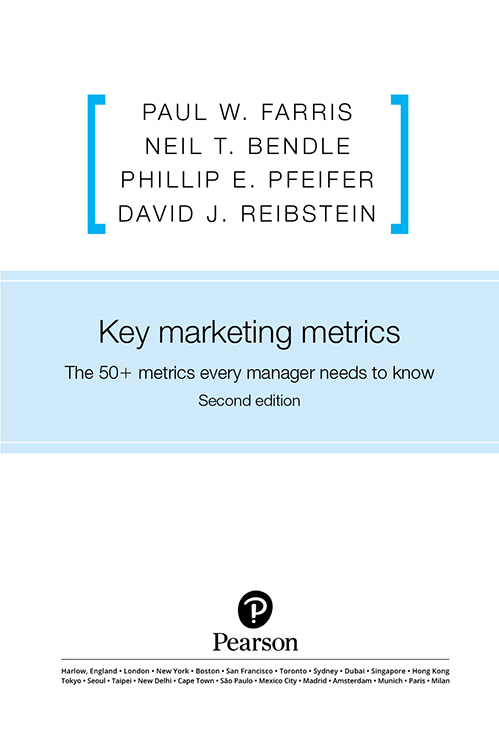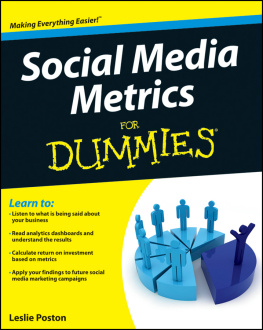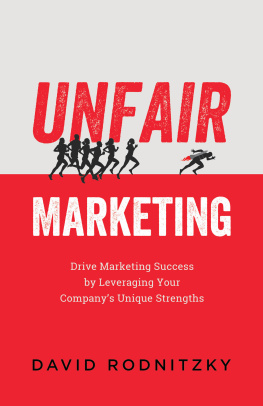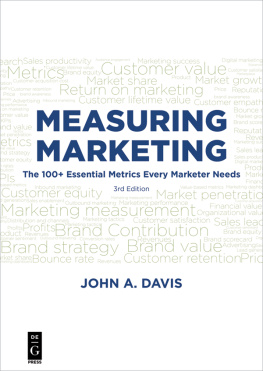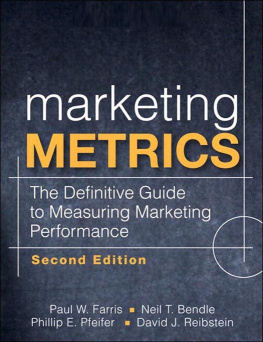Contents
We dedicate this book to our students, colleagues
and consulting clients who convinced us that
a book like this would fill a real need.
Acknowledgements
We hope this book will be a step, however modest, toward clarifying the language, construction, and meaning of many of our important marketing metrics. If we have succeeded in making such a step, we owe thanks to a number of people.
Jerry Wind reviewed our initial concept and encouraged us to set our sights higher. Rob Northrop, Simon Bendle and Vince Choe read early drafts and gave valuable feedback on the most important chapters. Eric Larson, Jordan Mitchell, Tom Disantis and Francisco Simon helped develop material for important sections and provided their research skills. Gerry Allan and Alan Rimm-Kauffman allowed us to cite liberally from their materials on customers and Internet marketing. We thank Valerie Redd and Kelly Brandow for their help in designing, testing and administering the survey of the metrics that senior marketing managers use to monitor and manage their businesses.
Marc Goldstein combined business savvy with deft editing touches that improved the readability of almost every chapter. Amy Neidlinger, Jeanne Levine, Andy Beaster, Debbie Williams, Nonie Ratcliff and their colleagues also made significant improvements in moving from a raw manuscript to the book in your hands.
Erv Shames, Erjen van Nierop, Peter Hedlund, Fred Telegdy, Judy Jordan, Lee Pielemier and Richard Johnson have collaborated on our Allocator management simulation and Management by the Numbers online tutorials. That work helped us set the stage for this volume. Finally, we thank Emily, Kate, Donna and Sarah, who graciously tolerated the time sacrificed from home and social lives for the writing of this book.
For the second edition we would also like to thank Raymond Pirouz and Liz Gray for sharing their opinions and expertise in respect to online marketing.
Thanks to Dr. Manuel Garcia-Garcia, Neuroscience Director, Nielsen and Adjunct Associate Professor, NYU Stern School of Business and Neuroscience UVA student Pasha Davoudian for their invaluable guidance and assistance with the section on neuro-marketing.
About the authors
Neil T. Bendle is an Assistant Professor of Marketing at the Ivey Business School, Western University, Canada. He holds a PhD from the Carlson School of Management, University of Minnesota, and an MBA from Darden. He has been published in journals such as Marketing Science and the Journal of Consumer Research. He has nearly a decades experience in marketing management, consulting, business systems improvement, and financial management. He was responsible for measuring the success of marketing campaigns for the British Labour Party.
Paul W. Farris is Landmark Communications Professor and Professor of Marketing at The Darden Graduate Business School, University of Virginia, where he has taught since 1980. Previously he was on the faculty of the Harvard Business School and worked in marketing management for Unilever. Professor Farriss research has produced award-winning articles on retail power, the measurement of advertising effects, and marketing budgeting. He has published many articles in journals such as the Harvard Business Review, Journal of Marketing, Journal of Advertising Research and Marketing Science. He is currently developing improved techniques for integrating marketing and financial metrics and is coauthor of several books, including The Profit Impact of Marketing Strategy Project: Retrospect and Prospects. Farriss consulting clients have ranged from Apple and IBM to Procter & Gamble and Unilever. He has also served on boards of manufacturers and retailers and as an academic trustee of the Marketing Science Institute.
Phillip E. Pfeifer, Richard S. Reynolds Professor of Business Administration at The Darden Graduate Business School, currently specialises in direct/interactive marketing. He has published a popular MBA textbook and more than 30 refereed articles in journals such as the Journal of Interactive Marketing, Journal of Database Marketing, Decision Sciences, and the Journal of Forecasting. In addition to academic articles and a textbook, Mr. Pfeifer is a prolific case writer, having been recognised in 2004 as the Darden Schools faculty leader in terms of external case sales, and in 2008 with a Wachovia Award for Distinguished Case Writer. His teaching has won student awards and has been recognised in Business Week s Guide to the Best Business Schools . Recent consulting clients include Circuit City, Procter & Gamble and CarMax.
Dr. David J. Reibstein is the William S. Woodside Professor and Professor of Marketing at the Wharton School, University of Pennsylvania. Dave has been on the Wharton Faculty for more than two decades. He was the Vice Dean of the Wharton School, and Director of the Wharton Graduate Division. In 19992001, Dave took a leave of absence from academia to serve as the Executive Director of the Marketing Science Institute. He previously taught at Harvard, and was a Visiting Professor at Stanford, INSEAD and ISB (in India). Dave was the Chairman of the American Marketing Association. He has a radio show, Measured Thoughts with Dave Reibstein, on SiriusXM Radio.
Foreword
Despite its importance, marketing is one of the least understood, least measurable functions at many companies. With sales force costs, it accounts for 10 percent or more of operating budgets at a wide range of public firms. Its effectiveness is fundamental to stock market valuations, which often rest upon aggressive assumptions for customer acquisition and organic growth. Nevertheless, many corporate boards lack the understanding to evaluate marketing strategies and expenditures. Most directorsand a rising percentage of Fortune 500 CEOslack deep experience in this field.
Marketing executives, for their part, often fail to develop the quantitative, analytical skills needed to manage productivity. Right-brain thinkers may devise creative campaigns to drive sales but show little interest in the wider financial impact of their work. Frequently, they resist being held accountable even for top-line performance, asserting that factors beyond their controlincluding competitionmake it difficult to monitor the results of their programs.
In this context, marketing decisions are often made without the information, expertise, and measurable feedback needed. As Procter & Gambles Chief Marketing Officer has said, Marketing is a $450 billion industry, and we are making decisions with less data and discipline than we apply to $100,000 decisions in other aspects of our business. This is a troubling state of affairs. But it can change.
In a recent article in The Wall Street Journal, I called on marketing managers to take concrete steps to correct it. I urged them to gather and analyse basic market data, measure the core factors that drive their business models, analyse the profitability of individual customer accounts, and optimise resource allocation among increasingly fragmented media. These are analytical, data-intensive, left-brain practices. Going forward, I believe theyll be crucial to the success of marketing executives and their employers. As I concluded in the Journal :
Todays boards want chief marketing officers who can speak the language of productivity and return on investment and are willing to be held accountable. In recent years, manufacturing, procurement and logistics have all tightened their belts in the cause of improved productivity. As a result, marketing expenditures account for a larger percentage of many corporate cost structures than ever before. Todays boards dont need chief marketing officers who have creative flair but no financial discipline. They need ambidextrous marketers who offer both.

